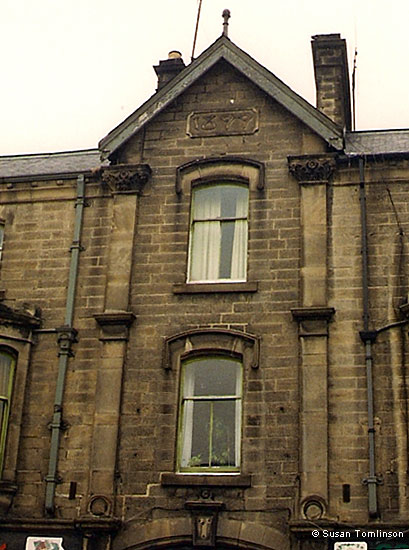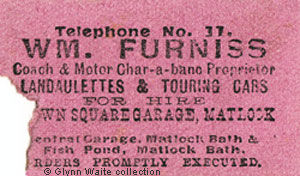|
Images Index> Matlock, 20th and 21stC Images> This page |
| Matlock: Furniss's Garage, Crown Square |
| Matlock : Twentieth Century Photographs, Postcards, Engravings & Etchings |
|
||||||||||||||||||
William Furniss senior (1861-1939) had arrived in Matlock with his wife and young family in the late 1880s, living first at Greenhill Terrace behind the Gate Inn[2]. Before his marriage he had worked as a butcher in Ardwick, Manchester[3]. He married Sarah Margaret Staniford, whose brother was the town crier[4], at St. Giles in 1883. In the late 1890s William was one of four proprietors who held the most vehicle licenses in Matlock: Messrs Hand and Son held eleven, Mr W. Furniss nine, Mr Jos. Boden eight, and Mr Anthony Walton five[5]. Building work to house his growing business as a posting master began on his new premises in Crown Square in early 1899. John William Wildgoose won the contract to build a livery stables, shops, etc. The architect was Mr. David Mark Wildgoose and the project was to cost about £2000. The block was to be built "near to the Bakewell Road and adjoining the premises of the chairman of the District Council", Edward Slack[6]. The development consisted of two shop fronts with a central arch between them through which the stables (later the garage) were accessed, with living accommodation above. The arch can still be seen, though it has been filled in. The Furniss's had a hairdressing business in one of the shops and Mrs. Furniss let out apartments (see advertisement below). Sarah Furniss died in 1909, aged 45, and William married May Brookhouse in 1910.
When he returned home after the war William Henry set up in business in his own right and in 1924 W. H. Furniss was one of three local bus companies running a service between Matlock and Cromford[1]. Sometimes the rivalry between the bus proprietors or their employees came to a head as it did in 1925 when a Furniss driver objected to the actions of a North Western driver and assaulted him in Matlock Bath. In the ensuing court case a local solicitor, Mr. Brooke Taylor, observed that "there was a deal of rivalry and a certain amount of hostile rivalry between the bus services". North Western were not allowed to pick up passengers in Matlock Bath but were clearly doing so, flouting the regulations that were in place[18]. Following the closure of the tramway in 1927, W. H. Furniss was dealt a blow when the Council left him off the list of bus companies they were considering for the new bus route up the Bank; they informed him that they didn't consider his bus suitable[1]. However, he continued to run a bus service, though not up the Bank. On 30 May 1928 Matlock UDC considered a list of applications for vehicle licenses. William Furniss (senior) applied for licenses for 3 vehicles and 3 drivers whereas William Henry Furniss applied for licenses for 5 vehicles, for 4 drivers and 1 conductor. Mr. Furniss Snr. owned a Motor Landaulette (for 6 passengers) and a motor charabanc (which would carry 14 passengers). W. H. Furniss owned a Motor Landaulette (also for 6 passengers), three motor charabancs (which would carry 14, 18 and 28 passengers respectively) and a motor omnibus that was designed to carry 32 people[19]. Along with several other local firms they sold their bus business to North Western in the early 1930s. W. H. Furniss had by then diversified and he and his sons became motor haulage contractors[15].
|
||||||||||||||||||
|
1. Postcard of Crown Square, Matlock". Published by Valentine's, No.88717 and registered in 1923. In the collection of and provided by and © Glynn Waite. Published on page 48 of Glynn's book (see below). 2. Photograph of the Crown Square property, probably taken in the 1990s © Susan Tomlinson. 3. "Wm. Furniss. Coach Proprietor Matlock". Postcard by R. and R. Bull of Ashbourne in the collection of, provided by and © Ann Andrews. Another version of this image has the words "Mrs. Grindy. Proprietress" instead of the Furniss name. 4. Furniss invoice in the collection of and provided by and © Glynn Waite. 5. Furniss's advertisement from "Abel Heywood's Guide Books, With Cycling, Walking and Driving Routes. Matlock Illustrated." (1903) Abel Heywood & Son, Manchester & London. In the collection of, provided by and © Ann Andrews. 6. Furniss receipt in the collection of and provided by and © Glynn Waite. 7. Tram ticket in the collection of and provided by and © Glynn Waite. Written and researched by and © Ann Andrews. Intended for personal use only. |
||||||||||||||||||
References (coloured links are to transcripts or more information elsewhere on this web site): [1] Waite, Glynn (2012) "The Matlock Cable Tramway", Pynot Publishing, 50 Main Road, Holmesfield, Dronfield, Derbyshire. ISBN 978-0-9562706-5-8. [2] The Furniss family were living on Rutland Street in the 1891 census and at Matlock Bridge at the time of the 1901 census [3] In 1881 William Furniss lived at 89 Exeter Street, Ardwick (RG11/3897 f53 p40 s207) [4] Robert Staniford was listed in the 1891 census and Kelly's 1891 Directory, Matlock Bank and Moor and Officials. He was a bill poster in the 1901 census. [5] "Derbyshire Times and Chesterfield Herald", 22 May 1897. [6] "ibid.", 14 January 1899. [7] Kelly's 1895 Directory (William Snr) | Kelly's 1899 Directory (William Snr) | Kelly's 1908 Directory, Matlock (William Snr) | Kelly's 1908 Directory, Matlock Bath (William Snr) | Kelly's 1916 Directory, Matlock (William Snr) | Kelly's 1916 Directory, Matlock Bath (William Snr) [8] "Derby Daily Telegraph", 15 January 1910. Fire at Matlock Bath. The stabling adjoining the New Bath Hotel, which were sublet to William Furniss, caught fire. [9] Reminiscences of the late Frank Clay. Private papers © Ann Andrews. This would have been 1913-14. [10] "Derby Daily Telegraph", 2 May 1912. The agreement was to be signed within next few days. [11] Mary E Allen was the daughter of James and Sarah Allen. Her brother, Albert William, was to die in the early stages of the war. See Matlock war memorial. [12] See Matlock's National Reservists & the Call-up Card. [13] Beresford, Charles (2007) "The Bath at War, A Derbyshire Community and the Great War". Country Books/Ashridge Press. ISBN 978 1 901214 91 8. [14] See both Matlock's War Memorial and Matlock Bath's War Memorial for John Clay and George Boden. [15] They advertised in the following post war trade directories: Kelly's 1925 Directory (William, Field House, Smedley Street; William Henry, Premier Garage, Bakewell Road, with offices on Causeway Lane; Also Premier Garage, Matlock Bath) | Kelly's 1932 Directory and Kelly's 1941 Directory (William Henry, motor haulage contractors, Field House, Smedley St). [16] From documents in Glynn Waite's collection. [17] Kelly's 1925 Directory. [18] "High Peak News", 10 Oct 1925. Rival Bus Drivers. Researched by Glynn Waite. [19] Glynn Waite extracted this information from an Omnibus Society publication about North Western buses,
which gave details of the vehicles the company inherited from other firms (and the dates) and what subsequently happened to them, although
not all were traced. |





















